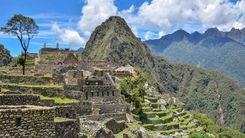The plaza’s exposed northeastern edge is dominated by the squat Catedral while the smaller Iglesia de la Compañía de Jesus, with its impressive pair of belfries, sits at the southeastern end.
La Catedral sits solidly on the foundations of the Inca Viracocha palace, its massive lines looking fortress-like in comparison with the delicate form of the nearby La Compañía. Construction began in 1560; the cathedral was built in the shape of a Latin cross with a three-aisled nave supported by only fourteen pillars. There are two entrances, one via the main, central cathedral doors; the other, more usual, way is through the Triunfo Chapel, the first Spanish church to be built in Cusco. Check out its finely carved granite altar and the huge canvas depicting the terrible 1650 earthquake, before moving into the main cathedral to see the intricately carved pulpit, beautiful cedar-wood seats and Neoclassical high altar, made entirely of finely beaten embossed silver, as well as some of the finest paintings of the Cusqueña school.
Icons and folklore
The cathedral’s appeal lies as much in its folklore and legends as in its tangible sights. Local myth claims that an Indian chief is still imprisoned in the right-hand tower, awaiting the day when he can restore the glory of the Inca Empire. The building also houses the huge, miraculous gold and bronze bell of María Angola, named after a freed African slave girl and reputed to be one of the largest church bells in the world. And on the cathedral’s massive main doors, native craftsmen have left their own pagan adornment – a carved puma’s head – representing one of the most important religious motifs and gods found throughout ancient Peru.



